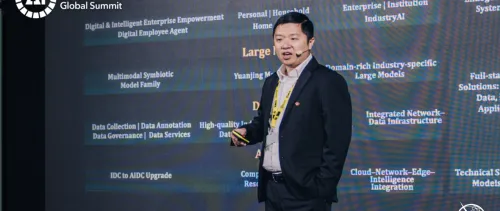
This year’s Youth Zone at the AI for Good Global Summit transformed Palexpo into a learning ground where creativity, curiosity, and code came together. Across two packed days, students, educators, and young innovators engaged in hands-on workshops exploring how AI and robotics can be used to solve real world challenges, from landmine detection to lunar health missions. With 16 workshops running in both English and French, the Youth Zone offered something for everyone, whether they were just starting out or already dabbling in Python. Children as young as five, along with teens and adults, took part in sessions designed to make AI concepts accessible and engaging, without requiring prior experience.
1/3 Youth Zone: Innovation for the next generation
This year’s Youth Zone at the AI for Good Global Summit transformed Palexpo into a learning ground where creativity, curiosity, and code came together. Across two packed days, students, educators, and young innovators engaged in hands-on workshops exploring how AI and robotics can be used to solve real world challenges, from landmine detection to lunar health missions. With 16 workshops running in both English and French, the Youth Zone offered something for everyone, whether they were just starting out or already dabbling in Python. Children as young as five, along with teens and adults, took part in sessions designed to make AI concepts accessible and engaging, without requiring prior experience.
There were standout session like “Robotics for Humanitarian Demining” where participants stepped into the shoes of humanitarian workers, guiding robots through simulated minefields to safely deliver supplies. Developed in partnership with the Global Shapers – Geneva Hub, this workshop gave attendees a powerful, hands-on look at how robotics can support life-saving efforts in conflict-affected areas.
In the “Moon Health Challenge: M.A.R.S Rover”, teams joined a space-inspired robotics mission, building and programming their own autonomous rovers to address planetary health problems. Combining coding, creative design, and systems thinking, the workshop turned science fiction into a STEM reality.
Creativity was also expanded with Candli, a workshop that allowed students to turn their hand-drawn characters and settings into fully functional video games, no coding experience was required. Using a combination of art, logic, and physics, participants scanned their own drawings and brought them to life through visual programming.
And for those who were eager to get started with robotics, the Thymio Discovery workshop introduced learners to the basics of robot behavior through playful exploration and visual coding. Participants programmed Thymio robots using intuitive tools and took on friendly challenges that encouraged experimentation.
Another major highlight of the Youth Zone was the Robotics for Good Youth Challenge Grand Finale, where student teams from around the world gathered to put their disaster-response robots to the test. After months of prototyping, coding, and teamwork, these young innovators, aged 10 to 18, arrived in Geneva representing 37 countries, bringing a truly global spirit to the competition.
This year’s challenge centered on a real-world problem: disaster response. Teams were tasked with designing and building robots capable of helping in emergency situations like floods or earthquakes. Whether it was navigating unstable terrain, delivering supplies, or identifying people in need, the mission required both technical skills and humanitarian thinking. All teams worked on the same core task and used free, open-source tools, showing creativity and collaboration. Youth from Africa to Asia to Latin America came to present their final projects and brought diverse ideas and cultural perspectives to the table.
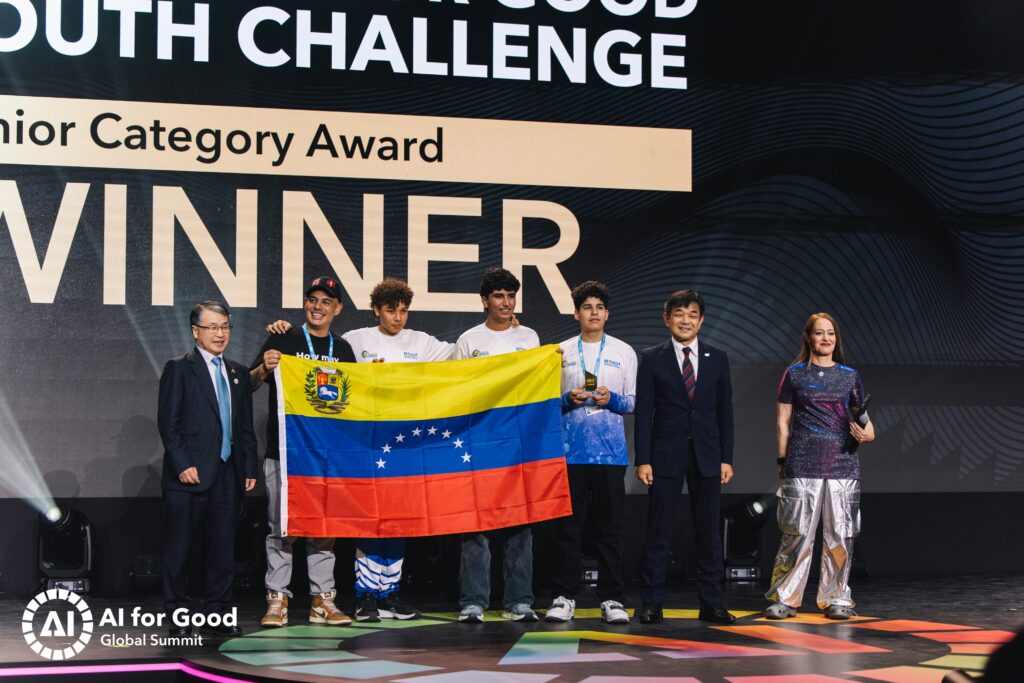
In the Junior Category, Venezuela’s “The Spartans” claimed the top spot, followed closely by Nepal’s “Team Gautam Buddha” in second place. Ghana’s “R Tech” proudly secured third, rounding out a remarkable showing of talent and creativity.
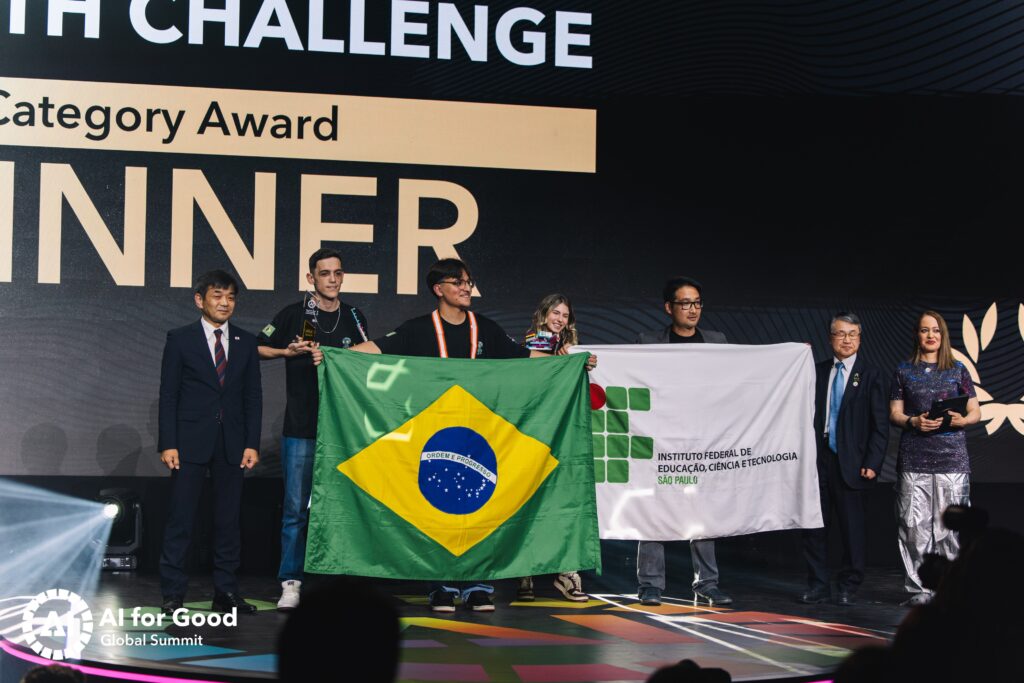
In the Senior Category, Brazil’s “Sancabots ae Resgate” were crowned champions, with South Korea’s “K-Robotics for Humanity” taking second place. Burkina Faso earned third, showing impressive problem-solving and resilience. These winning teams stood out for their technical excellence and their inspiring vision for how robotics can serve humanity.
The Robotics for Good Youth Challenge will return for the 2025–2026 edition on the topic of Food Security and applications to host a local event are now open. Public and private organizations are invited to apply to become local chapter organizers and bring the competition to students in their country. Apply by 1 September 2025 to host an in-person Robotics for Good Youth Challenge event.
Students without a local chapter can also participate by submitting a video entry by 1 April 2026. Learn more and apply
2/3 Art, AI, and human expression
The AI for Good Summit wasn’t just a space for science and innovation, it explored the ways AI can deepen human expression. Sound, stories, shared imagination: artists brought new perspectives on how technology can move, include, inspire.
In the AI Art Gallery, Japan-based KiQ brought a new perspective on human-machine interaction through movement. They presented a film and interactive VR Ikebana experience that invited visitors to reflect on non-verbal communication (gesture, breath, and posture) as a form of empathy. Rather than teaching machines to speak, the project explored how technology might learn to feel and respond to quiet, embodied signals of human presence. The AI Art Gallery also presented the digital art collection from Arab Bank Switzerland, which offered a rare look into their private digital art collection, featuring a curated set of pieces that highlight the convergence of finance, creativity, and innovation, showing audiences the growing recognition of digital and AI based art in institutional and cultural spaces, bridging contemporary expression with new technological frontiers. Furthermore, artist and technologist Harry Yeff (also known as Reeps One) invited audiences into a reflective encounter with the natural world. His latest work, Agentic Voicing Natures, used conversational AI and ecological data to breathe voice into endangered ecosystems and extinct species. Through four digital agents crafted in collaboration with ElevenLabs, the piece turned science into sculpture, inviting viewers to listen to the lost languages of nature. It was a reminder of what AI can preserve and what we stand to lose.
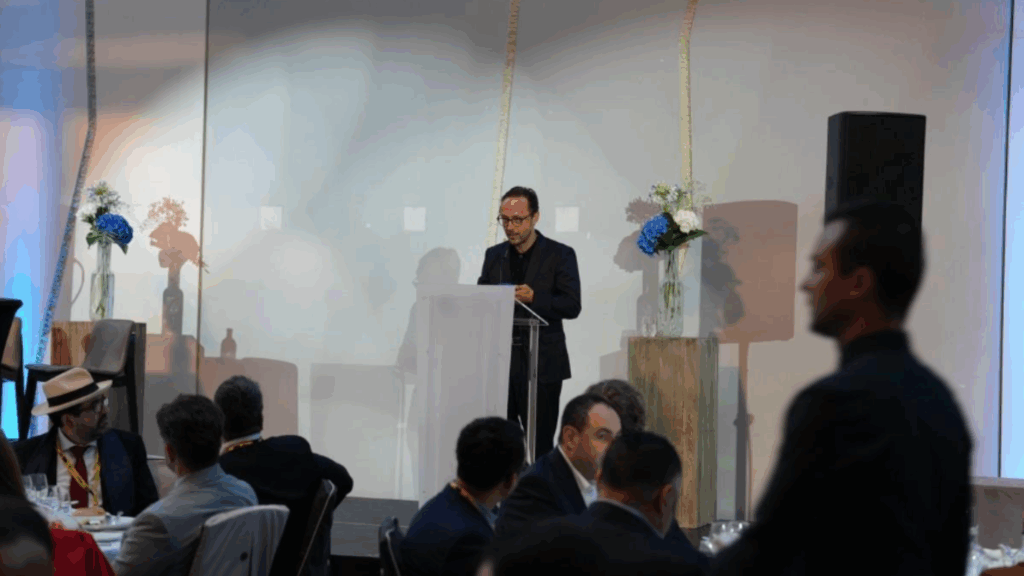
At the installation, Helin by artist and technologist Christian Mio Loclair, offers an AI-powered journey through artistic heritage. At its center is a striking dark marble sculpture, generated using a custom deep-learning framework trained on over 120,000 historical sculptures, enabling the AI to create new organic forms in real time. The result is an “organic data mirror” that reflects centuries of human artistic tradition through a fully digital creative process.
From a calm reflection to an up beat performance, the Summit stage lit up with the arrival of Big Ocean, the world’s first AI-powered K-pop group composed of deaf and hard-of-hearing artists. Jiseok, PJ, and Chanyeon took their dreams into their own hands, transforming their recorded voices using AI voice conversion to debut as a group earlier this year. Their performance of Hope, created through deep learning of their voices, showed the amazing breakthrough in inclusive creativity, achieved by leveraging AI. As their producer Haley Cha shared the journey behind their success, the audience learned how AI can help break down barriers.
Some meters away, another kind of collaboration unfolded. Students from Geneva’s creative school CREA brought AI to life through a towering interactive mural powered by a locally hosted language model. Summit visitors were invited to share their visions for a sustainable future, and these ideas were instantly transformed into glowing projections on the mural. With AI summarizing themes in real time, CREA’s team managed to transform public participation into a beautiful living artwork. Under the guidance of Dimitri Ganevat, the exhibit demonstrated how AI tools can be used in real time to motivate public engagement, creativity, and sustainability conversations.
Together, these experiences reminded everyone that AI isn’t only about what it can do, but also about what it can mean.
3/3 A Walk Through the Exhibitor Zone
The Exhibitor Zone at AI for Good 2025 brought together a diverse mix of universities, companies, nonprofits, and research teams representing countries from across the world. Each was presenting a different way to apply AI, whether to improve health, restore ecosystems, enhance education, or explore new frontiers in robotics. Here’s a small glimpse at some of the work they presented.
Qure.ai (India), using AI to fight global health inequities, Qure.ai’s qXR tool can detect over 35 lung abnormalities, including TB and cancer, in under a minute. Trained on over five million chest X-rays, it’s helping health systems in resource-limited settings deliver faster and more accurate diagnoses. Dendra Systems (Australia) is reforesting the planet from above and using drones and AI to accelerate ecosystem restoration. Their platform captures ecological data, generates insights, and automates aerial seeding, making land rehabilitation faster, cheaper, and more precise.
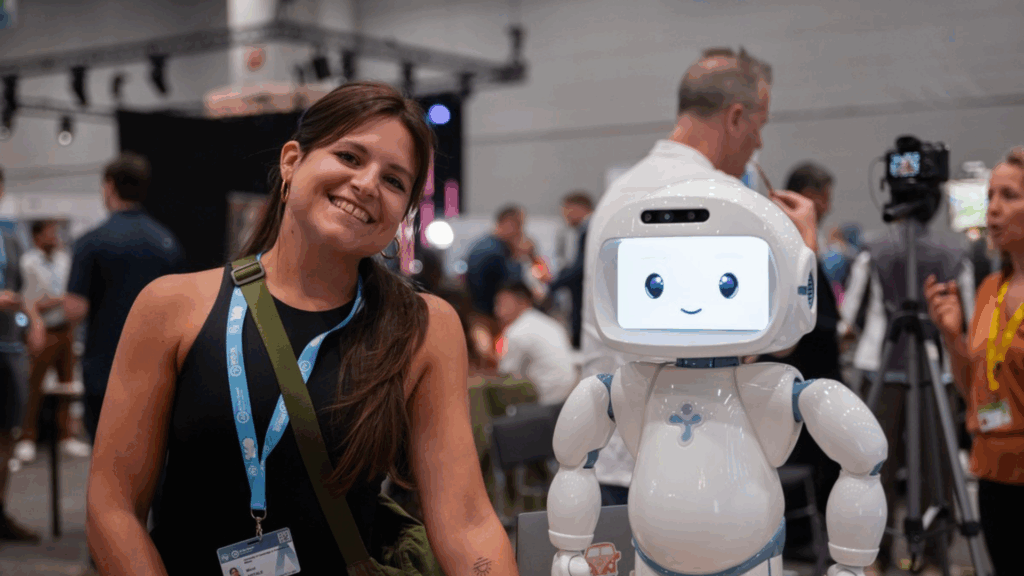
QTrobot for autism (Luxembourg/Belgium) is changing the game in inclusive education with their expressive robot. Designed to support autistic children, QTrobot offers structured, play-based lessons backed by research, helping learners stay engaged while also empowering caregivers and educators with scalable, personalized tools. NomadZ – ETH Zurich (Switzerland) presented robots with a soft touch and strong team spirit. NomadZ is ETH Zurich’s RoboCup team developing autonomous football-playing robots. Their work pushes the boundaries of collaborative AI and robotics for human-friendly environments.
Sophia and Robert, from Hanson Robotics & RB Labs (Hong Kong & USA) are two lifelike humanoid robots designed to advance education, therapy, and financial literacy. Behind their expressive faces lies cutting-edge research into neurosymbolic AI and socially meaningful human-machine interaction. Nature-Inspired Flying Robots from EPFL Laboratory of Intelligent Systems (Switzerland) have designed flapping drones, nature-inspired robots that mimic the agility and adaptability of birds and insects. These compact, bio-inspired machines could reshape search and rescue missions, wildlife observation, and scientific discovery.
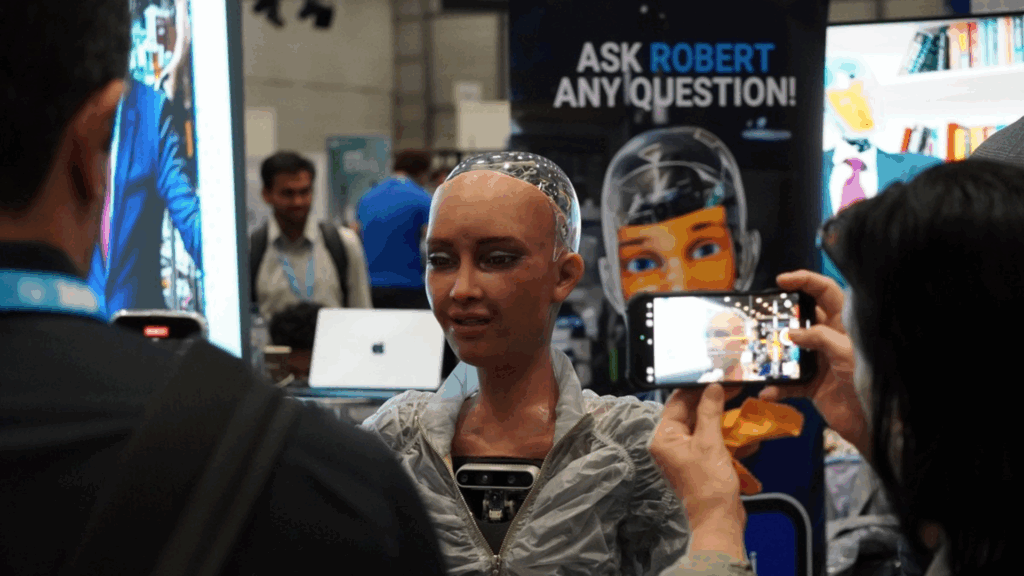
Ai-Da Robot (UK) is the world’s first ultra-realistic robot artist, drawing, painting, and performing while asking tough questions about creativity, consciousness, and our AI-shaped future. Her presence challenged audiences to reflect on where art ends and algorithms begin. CERNBot from CERN is built for the world’s largest particle physics lab, and it handle dangerous and delicate tasks underground so humans don’t have to. From maintenance to monitoring, these mobile systems showcase how robotics can safely extend our reach into extreme environments.
MagTip from Bristol Robotics Lab (UK) is giving robots the gift of touch, MagTip is a fingertip-sized sensor that helps machines detect contact with sub-millimetre precision. This tiny innovation has big implications for dexterous robotics, prosthetics, and safe human-robot collaboration. Asian Development Bank (ADB) brought a policy perspective to AI for good, ADB highlighted how technology can support inclusive and sustainable development across Asia and the Pacific. Their presence emphasized the importance of multilateral action in shaping ethical AI futures.
Each of these exhibitors brought a unique vision of how AI can improve lives across sectors, disciplines, and continents. Together, they offered a hopeful and practical look at the future of intelligent systems in service of people and planet.
Inspired by these projects? If you’re working on an AI solution that tackles world challenges, consider joining the next AI for Good Summit as an exhibitor. Apply here to show your work.
